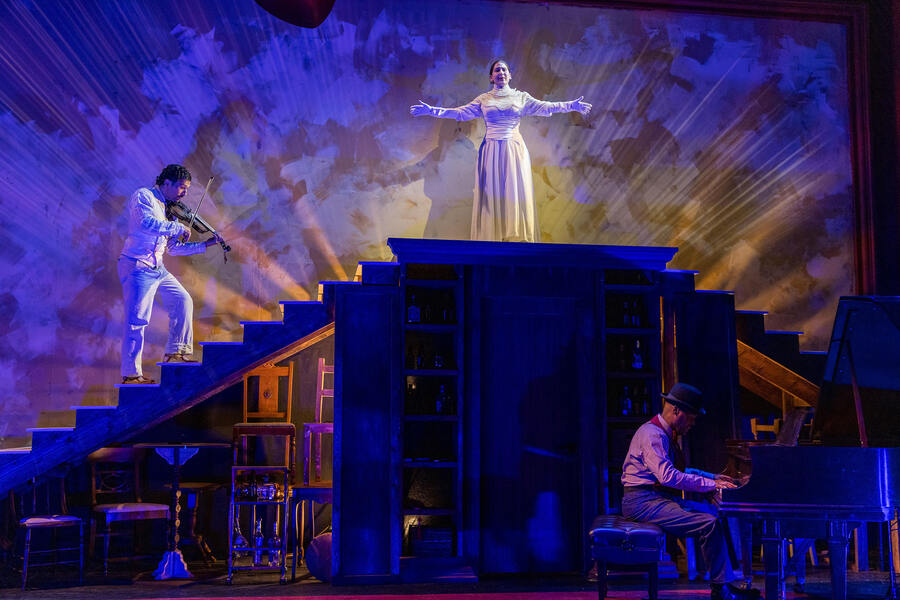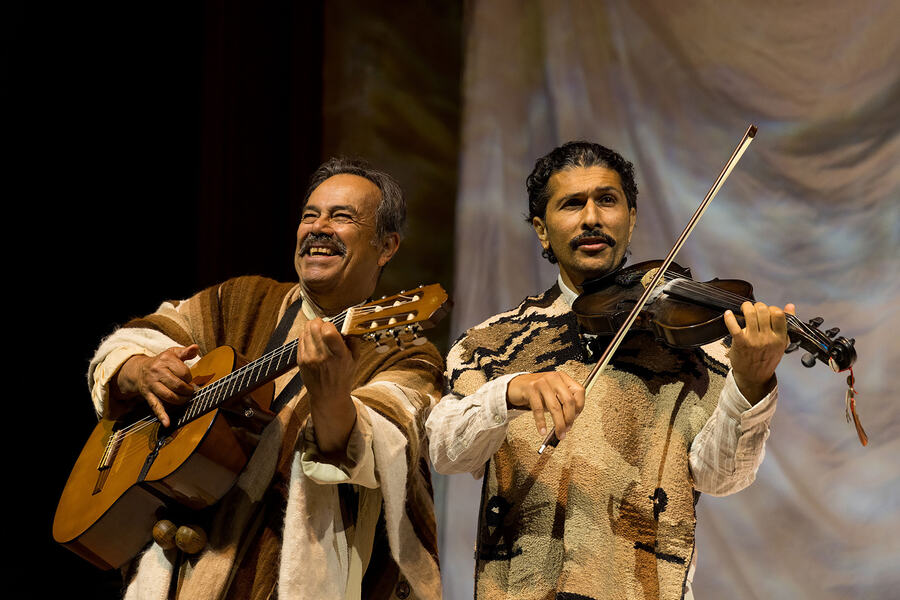Quetzal Guerrero stepped onstage as Juventino Rosas and started playing a familiar tune on the violin, swaying with the melody and easing into a waltz with his feet. Other characters around him called the tune a “happy sad” song, and undeniably Mexican.
At first listen, the melody sounds familiar, reminiscent of carnivals or cartoons. In fact, the song is so recognizable because it has traveled the world—including calliopes, video games, and cartoon soundtracks—since it was written in the late 1800s, under the title “Sobre las Olas” (Over the Waves). But while the tune is ubiquitous, its composer, Rosas, an Indigenous Mexican, was all but forgotten after his death at 26.
Ghost Waltz, Oliver Mayer’s new play, in its world premiere with Latino Theater Company at the Los Angeles Theatre Center, aims to recover the true story of the beloved song and portray the artists of color who often go uncredited, even today, for their cultural contributions.
“It’s not unlike an archeological dig,” Mayer said. “I’m trying to uncover the bones of a long, buried life.”
Mayer hadn’t planned to write a play about Rosas. The composer came to him in a dream, he said, attempting to waltz in his huaraches while a crowd of people dressed in white watched. Mayer woke up and wrote a page of dialogue, soon recognizing the journey of rediscovery ahead.
“I feel like it’s my privilege to bring the story to light now,” he said. “It feels to me every time we listen to his music, he comes back to life. Every time we talk about him, he comes back to life.”
Part of bringing Rosas back to life is setting him alongside his contemporaries, said director Alberto Barboza. In the play, audiences are also introduced to historical figures like Scott Joplin, played by pianist and composer Ric’Key Pageot, and opera singer Ángela Peralta, played by soprano Nathalie Peña-Comas. Guerrero, Pageot, and Peña-Comas—each a prominent musical artist in their own right—were specifically cast to mirror the energy Rosas and his peers would have brought into a room.
Before stepping into the role of Peralta, also known as the Nightingale, Peña-Comas had no clue who her character represented. Throughout the rehearsal process, she uncovered Peralta’s story as the first Mexican opera singer to sing in major European theatres, including La Scala. She even went on to form her own company.
“She knew what she had and she used it,” Peña-Comas said. “For me, this is an inspiration to keep going.”

For his part, Guerrero found Rosas’s background strikingly similar to his own: Both came from musical families, have Indigenous ancestry, studied in a conservatory, and primarily played the violin. The strong connection makes playing his music in Ghost Waltz much more intimate.
“Because I study music for my life, I feel like it speaks to me in a much deeper way than if I was just an actor,” he said.
Barboza—who previously directed a staged reading of the play for Latino Theater Company’s Circle of Imaginistas in January 2023—sought to use music as a guide for the full production. The play is packed with music, but not like a musical. Music shapes the sonic environment of Ghost Waltz, speaking to the period and the personalities onstage.
To create the musical landscape and historical context of the show, Barboza searched for documentation of the composer. He found a book in the UCLA and USC libraries, but not much else. During a trip to Mexico City, he visited three of the largest bookstores there in hopes of finding more resources about Rosas, to no avail. Upon returning to L.A., he spoke with Josh Kun, a professor of cross-cultural studies at USC, who confirmed that books on Rosas are scarce. Barboza quickly recognized the weight of Ghost Waltz: This would be a play about “recovering people that have been whitewashed,” as he put it.
“This is a story about a song,” Guerrero said. “It’s a story about a song that took wings, made its presence known throughout the world and made history. Now we get to see how that song was created and where it came from. But the decolonization part is the realization that what we’ve been told and what we’ve been taught to think is never the case.”
Ghost Waltz takes part in decolonization by giving voice to perspectives that have been excluded. One place this shows up is in the subtle intricacies and details Barboza and Guerrero put into their representation of Otomi, the Indigenous people who constitute Rosa’s background.
Ariel Brown, who plays Bethena, said she found her point of entry into the show’s themes with the line: “A hundred years from now? People won’t care about the money you made or the way the notes are written down. It’s what’s between the notes.”
She isn’t just talking about the emotional core of the music. Bethena, a Black woman living around 20 years after the 13th Amendment abolished slavery in the U.S., means that between the lines, she feels free. As Brown put it, “It’s impactful for this character to be able to play music and travel and stand on the notion that she is free.”
Mayer crafted the characters with great intentionality, to ensure their backgrounds are salient in their every move. His goal is to remind audiences that while we may now see them as historical figures, they were just living everyday lives, worrying about getting their next meal and making a living. As Rosas comes to life onstage through Guerrero, audiences can see and feel how he may have carried himself or filled a room with his music.
In highlighting forgotten luminaries from the past, Ghost Waltz also serves as a reminder to value overlooked people who are alive today.
“The past is one thing, and it’s great to recover those great inspirations from the past, but the truth is the present is what we need to be worried about,” Mayer said. “All the people who are doing all the good work and not getting the attention that they deserve—people in this room right now. We need to do better, and we can start today.”
Steven Vargas (he/him) is a multimedia journalist, dancer, and actor based in Los Angeles whose work focuses on the intersections of media, social justice, and performance. His work can be found in publications like the Los Angeles Times, E! News, USA Today, TheWrap, Dance Magazine, and ARTnews.


